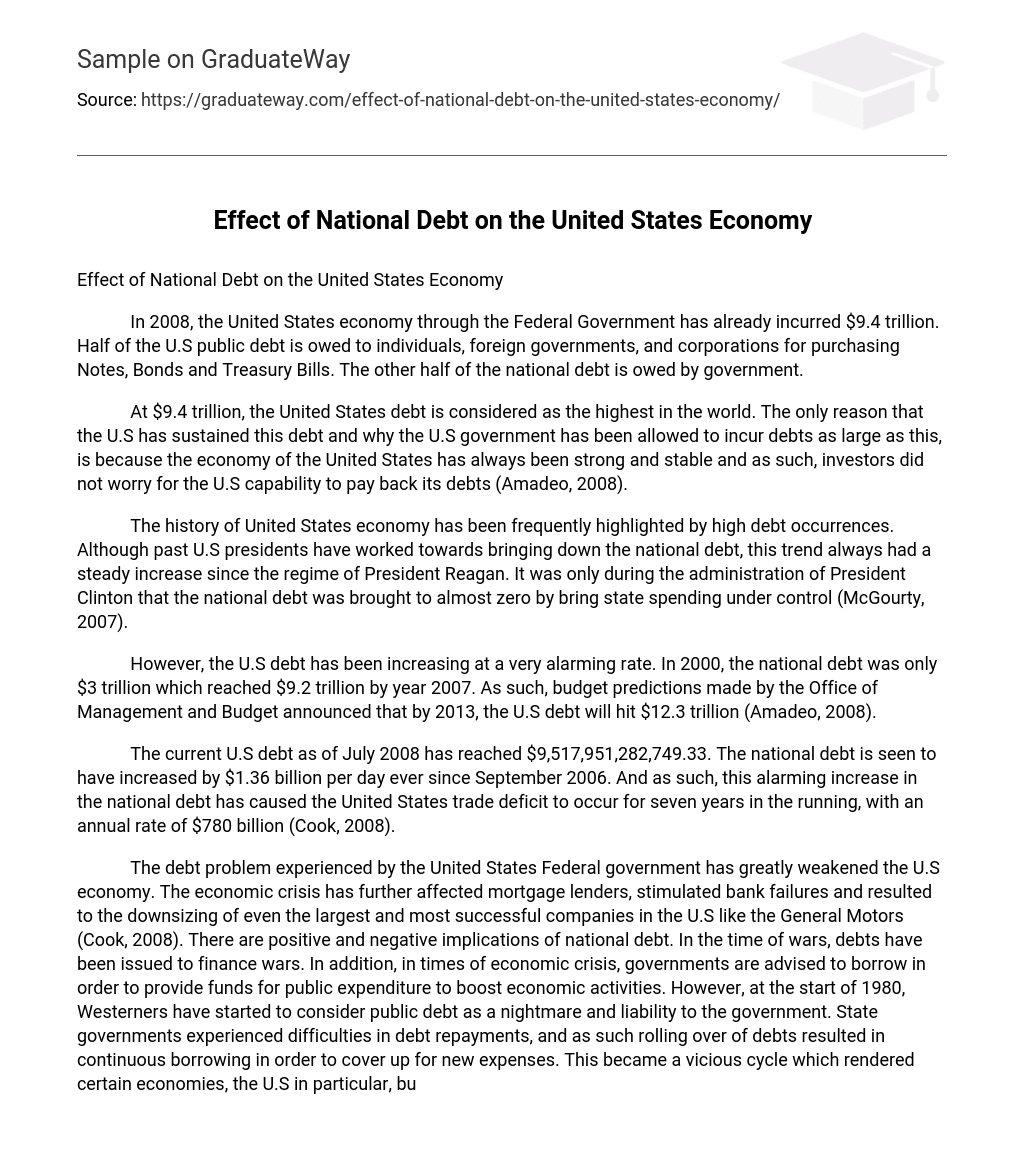In 2008, the United States economy through the Federal Government has already incurred $9.4 trillion. Half of the U.S public debt is owed to individuals, foreign governments, and corporations for purchasing Notes, Bonds and Treasury Bills. The other half of the national debt is owed by government.
At $9.4 trillion, the United States debt is considered as the highest in the world. The only reason that the U.S has sustained this debt and why the U.S government has been allowed to incur debts as large as this, is because the economy of the United States has always been strong and stable and as such, investors did not worry for the U.S capability to pay back its debts (Amadeo, 2008).
The history of United States economy has been frequently highlighted by high debt occurrences. Although past U.S presidents have worked towards bringing down the national debt, this trend always had a steady increase since the regime of President Reagan. It was only during the administration of President Clinton that the national debt was brought to almost zero by bring state spending under control (McGourty, 2007).
However, the U.S debt has been increasing at a very alarming rate. In 2000, the national debt was only $3 trillion which reached $9.2 trillion by year 2007. As such, budget predictions made by the Office of Management and Budget announced that by 2013, the U.S debt will hit $12.3 trillion (Amadeo, 2008).
The current U.S debt as of July 2008 has reached $9,517,951,282,749.33. The national debt is seen to have increased by $1.36 billion per day ever since September 2006. And as such, this alarming increase in the national debt has caused the United States trade deficit to occur for seven years in the running, with an annual rate of $780 billion (Cook, 2008).
The debt problem experienced by the United States Federal government has greatly weakened the U.S economy. The economic crisis has further affected mortgage lenders, stimulated bank failures and resulted to the downsizing of even the largest and most successful companies in the U.S like the General Motors (Cook, 2008). There are positive and negative implications of national debt. In the time of wars, debts have been issued to finance wars. In addition, in times of economic crisis, governments are advised to borrow in order to provide funds for public expenditure to boost economic activities.
However, at the start of 1980, Westerners have started to consider public debt as a nightmare and liability to the government. State governments experienced difficulties in debt repayments, and as such rolling over of debts resulted in continuous borrowing in order to cover up for new expenses. This became a vicious cycle which rendered certain economies, the U.S in particular, buried in public and national debts and made such economies vulnerable and less stable (“Business: The Economy Exorcising the US National Debt,” 1999).
The Bush administration in particular has been highlighted with an ever increasing rate of debt accumulation. Debt leveraging and continuous inflation in the price of oil made the U.S economy a big catastrophic event (Heinberg, 2008). And as such, high debt rate in the United States caused its economy to slow down. In line with this, the foreign holders of the U.S debt have chosen to invest on their own economy rather than on the U.S. Consequently, the decline in the demand rate for U.S Treasuries has increased the interest rate while further contributing to the economic slow down. Moreover, the ongoing slump in demand caused the dollar to lose its value. The dollar value has lessened because the dollar denominated Treasury Securities, which has grown less desirable nowadays (Amadeo, 2008).
Apart from economic issues which gravely suffered due to the increase in national debt, the social sector has been deprived of the privileges that are originally alloted for it. Higher taxes being collected by the Federal Government have been used to finance debts and loans repayments (Amadeo, 2008). As such, the benefits for privileged individuals have been curtailed to give way to other expenditures that have to be made by the government.
Thus, the continuous increase in the public debt has caused the United States economy to slow down and stagger behind. And the Federal Government continuously fails to address such problems in debt repayment, the country’s economy will continue to suffer more.
References
- Amadeo, K. (2008). The U.S National Debt and How it Got so Big. About.com. Retrieved August 8, 2008, from http://useconomy.about.com/od/fiscalpolicy/p/US_Debt.htm
- Business: The Economy Exorcising the US National Debt. (1999). BBC News. Retrieved August 8, 2008, from http://news.bbc.co.uk/1/hi/business/the_economy/380923.stm
- Cook, R.C. (2008). Status Report on the Collapse of the U.S Economy. Global Research. Retrieved August 8, 2008, from http://www.thewe.cc/contents/more/archive/us_debt.html
- Heinberg, R. (2008). Peak Everything Economics, or, What Do You Call This Mess? Global Public Media. Retrieved August 8, 2008, from http://globalpublicmedia.com/heinberg_peak_everything_economics
- McGourty, S. (2007). United States National Debt: An Analysis of the Presidents Who Are Responsible for the Borrowing. Retrieved August 8, 2008, from http://www.cedarcomm.com/~stevelm1/usdebt.htm





